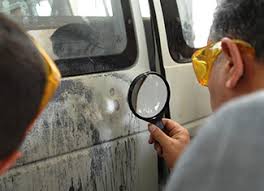With crime scene forensics improving over time, and the technology supporting the process becoming ever-more sophisticated, it's no surprise that we've accepted as fact that investigators can precisely identify one – and only one – person who left a fingerprint behind.
In the real world, prosecutors routinely present criminal cases that include fingerprint evidence. And of course, in the fictitious world of television, no good police series worth its salt can survive without a steady dose of "gotcha" moments derived from crime-scene sleuthing.
This all means that, for the purposes of ID-ing the only person who could have made that print, we've accepted fingerprinting to be foolproof. Lift the print and you have your perp.
Right? Well, according to defenders of science, no. That's incorrect they say.
A working group with the American Association for the Advancement of Science released a new report stating that any claim of precision in identifying a specific person from a fingerprint is "indefensible" and has no scientific foundation.
“We have concluded that latent print examiners should avoid claiming that they can associate a latent print with a single source," the report states, "and should particularly avoid claiming or implying that they can do so infallibly, with 100% accuracy.”
The report, entitled "Forensic Science Assessments: A Quality and Gap Analysis," written by William Thompson, John Black, Anil Jian and Joseph Kadane, details the weak spots in the process and includes 14 recommendations to address them. The group is comprised of a forensic scientist, an academic statistician, a psychologist and a biometric engineer.
The primary reason for the authors' claim, they write, is that while examiners can rule out the vast majority of the population, "insufficient data exist to determine how unique fingerprint features really are, thus making it scientifically baseless to claim that an analysis has enabled examiners to narrow the pool of sources to a single person."
 While it's true that when the fingerprints of all 10 digits are taken together, there's an excellent – potentially near-perfect – chance of identifying a single person. But certainly, when it comes to crime-scene collection, examiners very rarely come across all 10 prints – and all of which that are in usable condition. And as a matter of simple reasoning and logic, there can never be 100% certainty in positively identifying an individual, because to do so investigators would need access to fingerprint records of everyone alive on Earth. And that, of course, is not possible, among many other reasons, because millions of people are constantly being born all over the globe.
While it's true that when the fingerprints of all 10 digits are taken together, there's an excellent – potentially near-perfect – chance of identifying a single person. But certainly, when it comes to crime-scene collection, examiners very rarely come across all 10 prints – and all of which that are in usable condition. And as a matter of simple reasoning and logic, there can never be 100% certainty in positively identifying an individual, because to do so investigators would need access to fingerprint records of everyone alive on Earth. And that, of course, is not possible, among many other reasons, because millions of people are constantly being born all over the globe.
Now, critics may say, isn't this thought process rather ridiculous? Because when police are attempting to apprehend a suspect who committed a crime, of course not every single person on the planet was in a position to commit the crime. Yes, that's true. But what the authors are pointing out is an essential distinction, namely that investigators and prosecutors must recognize the flaws in the current process, flaws which exist and cannot be overlooked when scientific standards are applied.
As a result, while current practices can eliminate most everyone from consideration, they are not perfect and the working group cautions against declarations that a suspect is "positively identified" or that prosecutors are "absolutely certain" that they have their man.
The AAAS, which, it claims "marked the emergence of a national scientific community in the United States" when it was founded in 1848, is today the "world's largest multidisciplinary scientific society and a leading publisher of cutting-edge research," according to its website.




